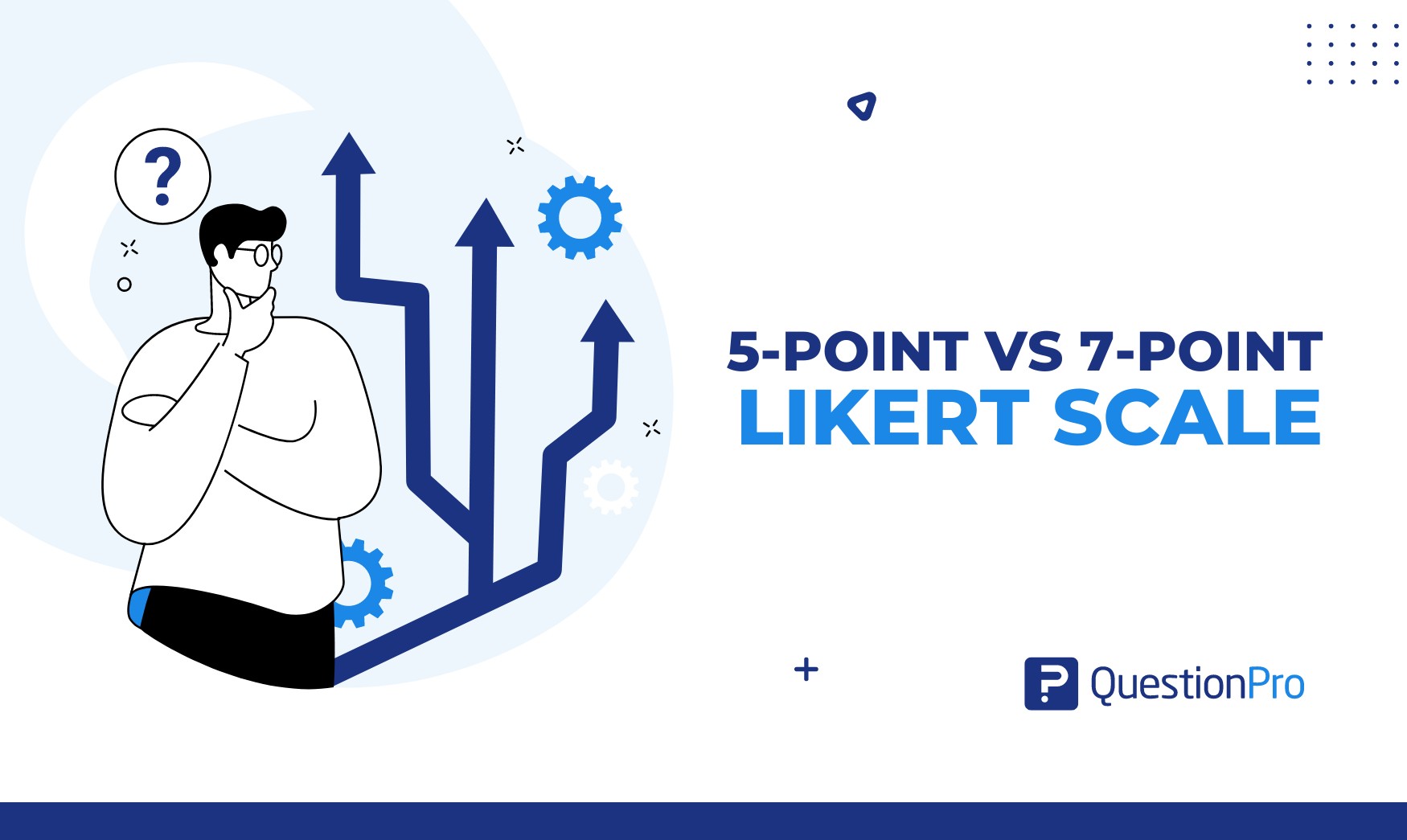
Likert scales are commonly used in surveys and questionnaires to measure attitudes, opinions, and perceptions. The 5-point vs 7-point Likert scale argument is one of many choices researchers face when designing surveys.
Each scale offers unique characteristics that influence respondent burden and data quality, making the decision of which to use crucial for obtaining accurate insights.
Deciding whether to use a 5-point vs 7-point Likert scale depends on several factors, including the level of detail required for measurement, the complexity of the topic being explored, and the preferences of the researcher or organization conducting the survey.
In this blog, we will examine the differences between a 5-point vs 7-point Likert scale, examining their respective advantages, disadvantages, and suitability for different survey contexts.
What is the Likert Scale?
A Likert scale is a tool researchers use to gather people’s opinions and attitudes. It’s a psychometric scale commonly involved in understanding the views on a brand, product, or target market. It delivers more data points to run statistical information. It’s important to have this in mind when comparing a 5-point vs 7-point Likert scale.
Different types of scales, like the Guttman, Bogardus, and Thurstone scales, focus on measuring opinions. Psychologist Rensis Likert made a clear difference between a scale based on a set of responses to several items, where responses are rated on a range of values.
For example, you can collect specific feedback on a product using a Likert Scale question. Instead of asking, “Was the product a good purchase?” with options to agree or disagree, you can ask your customer, “How satisfied are you with the product?” with options ranging from extremely dissatisfied to extremely satisfied.
The Likert Scale is commonly used by researchers to collect opinions on customer satisfaction or employee experience. This scale can be categorized into two main types:
- Even Likert Scale: Researchers collect significant feedback without a neutral response using even Likert Scale. Ex. 4-Point Likert Scale vs 8-Point Likert Scale.
- Odd Likert Scale: The odd Likert scale lets researchers ask respondents to respond or react with a neutral option. Ex. 5-Point vs 7-Point Likert Scale.
5-Point Likert Scale
A 5-point Likert scale is a commonly used psychometric scale that measures respondents’ attitudes or opinions on a symmetric agree-disagree scale.
It typically ranges from 1 to 5, with 1 representing “Strongly Disagree,” 2 representing “Disagree,” 3 representing “Neutral” or “Neither Agree nor Disagree,” 4 representing “Agree,” and 5 representing “Strongly Agree.”
This scale provides a simple and efficient way to gather data on people’s attitudes or perceptions towards a particular topic.
For instance, when designing a survey to evaluate a product, consider incorporating questions like:
- How satisfied are you with the overall performance of this product?
- How satisfied are you with the after-sales support for this product?
Using a 5-point scale from “Extremely Satisfied” to “Extremely Dissatisfied,” people can share their feelings in detail. This helps gather a wide range of feedback without making the survey too complex.
Using this scale makes it easier to understand responses and draw useful conclusions from the data. Also, participants can express their opinions clearly and simply, improving the survey experience and improving the feedback quality.
7-Point Likert Scale
The 7-point Likert scale is commonly employed in surveys and questionnaires to measure how people feel or think about a particular topic. The reason behind increasing the scale points is to cover the diversity of customers’ mindsets, as everybody has different responses and feelings.
It ranges from 1 to 7, where 1 indicates strong disagreement or being very unlikely, and 7 indicates strong agreement or being very likely. The midpoint, labeled as 4, typically signifies a neutral opinion or neutral-leaning stance. This scale provides more options for responses compared to the standard 5-point Likert scale.
On a 7-point scale, 3 means somewhat agree, and 5 means somewhat disagree, allowing participants to offer more detailed and nuanced feedback.
When evaluating a new product’s quality, price, and accessibility, the 7-point Likert scale allows for more detailed feedback. It provides respondents with a wider range of options, enabling them to express subtle differences in their thoughts and experiences. This detailed input is valuable for evaluating and enhancing the product.
However, it’s important to recognize some drawbacks of the 7-point scale. The increased options might cause survey fatigue, as respondents may find it time-consuming and mentally taxing to navigate through multiple choices. Additionally, some participants may feel overwhelmed by the abundance of options, potentially leading them to skip the questionnaire altogether.
Despite these challenges, the 7-point Likert scale presents an opportunity to gather nuanced feedback and comprehensively understand respondent attitudes toward the new product. By carefully considering the scale’s benefits and limitations, researchers can design surveys that maximize data quality while minimizing the burden on respondents.
Advantages of 5-Point vs 7-Point Likert Scale
The 5-point vs 7-point Likert scales are commonly chosen in surveys due to their simplicity, comprehensiveness, and effectiveness. These scales have shared features that make them useful in research surveys:
- The 5-point and 7-point Likert scales offer many alternatives, including a neutral midpoint.
- Both scales allow respondents to express their thoughts clearly, helping them understand their choices.
- Likert scale surveys promote honesty and transparency. It encourages honest feedback and improves data quality.
- Likert scales produce structured, quantitative data, allowing researchers to gain actionable insights and make informed judgments.
By using Likert scales, especially the 5-point and 7-point types, organizations can tap into the combined insights of their stakeholders. This helps improve and fine-tune the new product, making it more appealing in the market and increasing customer satisfaction.
5-Point vs 7-Point Likert Scale: Which One is to Use?
When deciding between a 5-point vs 7-point Likert scale, it’s important to think about your participants and research objectives. Each scale has its own benefits and factors to consider, which can affect how well your survey is designed.
When conducting surveys for a wide audience, especially when it’s important to keep things simple and clear, you might find the 5-point Likert scale to be a good choice:
- The simple method makes it easy for people to share their feelings quickly.
- The uncomplicated scale is easy for both researchers and participants to understand and use.
- Even though it’s short, the 5-point scale offers different choices, ensuring important insights are gathered.
However, if your research goals demand more detailed and precise feedback, the 7-point Likert scale can be a better choice:
- The 7-point scale provides more choices for answers, helping to better understand what people think in a detailed way.
- This extra detail is useful for research that aims to delve into complicated ideas or collect very specific opinions about products or services.
- Yet, thinking about possible downsides is crucial, like making it harder for people to answer or making data analysis more complex.
When analyzing the results, it’s important to consider the pros and cons of each scale. The seven-point Likert items can give more detailed insights, but it might take more time to analyze, especially in big surveys or when there’s limited time. On the other hand, the 5-point scale is a simpler option that can be more efficient for capturing general sentiments.
Alternative Survey Rating Scales
When conducting a survey, you can use different scales instead of just the Likert scale to get different kinds of feedback. Here are some other survey rating scales that researchers often use:
2-point Survey Scale
- Also known as a dichotomous or binary scale, this scale presents respondents with two absolute options: yes and no, true and false, or agree and disagree.
- Example: “Are you satisfied with the product?” (Options: Yes / No)
3-point Survey Scale
- The 3-point scale offers respondents a middle ground in addition to two extreme opinions, providing a neutral option.
- Example: “How satisfied are you with our onboarding?” (Options: Unhappy / Neutral / Happy)
10-point Survey Scale
- Providing a broader range of options, the 10-point scale allows for more nuanced responses and clearer indications of sentiment.
- Example: “How likely are you to continue with the platform in the next year?” (Options: 1 to 10, with 1 being “Very Unlikely” and 10 being “Very Likely”)
11-point Survey Scale (NPS)
- Utilizing a scale ranging from 0 to 10, the 11-point NPS scale measures customer loyalty towards a brand.
- Promoters: Choose 9 or 10
- Passives: Choose 7 or 8
- Detractors: Choose 0 to 6.
- Example: “How likely are you to recommend our product/service to a friend or colleague?” (Options: 0 to 10)
How to Create Effective Likert Scale Survey Questions?
When creating Likert scale survey questions, it’s crucial to be clear and pay close attention to details. Here is how you can write these questions effectively.
Be Specific
Make sure to clearly state the subject or context of your question so that respondents have the information they need. For instance, rather than asking a general question like “How satisfied are you with the product?” be more specific by mentioning the product in question, like “How satisfied are you with the performance of Product A?
Label all the Options Properly
Make sure to label all the response options in the Likert scale so that people can easily understand their different choices. Instead of just labeling the ends (like “Strongly Disagree” and “Strongly Agree”), provide titles for all options to ensure a thorough understanding.
Be Careful with Sequence
Make sure the response choices in your survey’s Likert scale questions follow a consistent order. If you’re using horizontal rating scales, organize the options from negative to positive, placing the negative response attributes on the left and the positive attributes on the right. Keeping this order consistent will avoid confusion and help respondents clearly understand the questions.
Ensure Consistency
Make sure that the order of response choices in Likert scale questions remains the same throughout the survey. Whether organizing options from negative to positive or the other way around, keep the sequence consistent to improve clarity and reduce confusion for respondents.
Use the Likert Scales in Your Survey with QuestionPro!
Now that we have covered the 5-point vs 7-point Likert scale, let’s talk about how the Likert scale survey effectively gathers feedback and valuable information, making it easy to comprehend and respond to. It plays a crucial role in assessing opinions or attitudes on a specific topic, providing valuable insights for the next stages of an investigation.
Using QuestionPro, organizations can easily conduct online surveys utilizing the Likert Scale. Simply create a free account to begin exploring and testing this type of question.
For additional information about this and other features on our platform, feel free to reach out to our online chat. Share details about your project, and we’ll be happy to recommend the research tools that best fit your needs.







